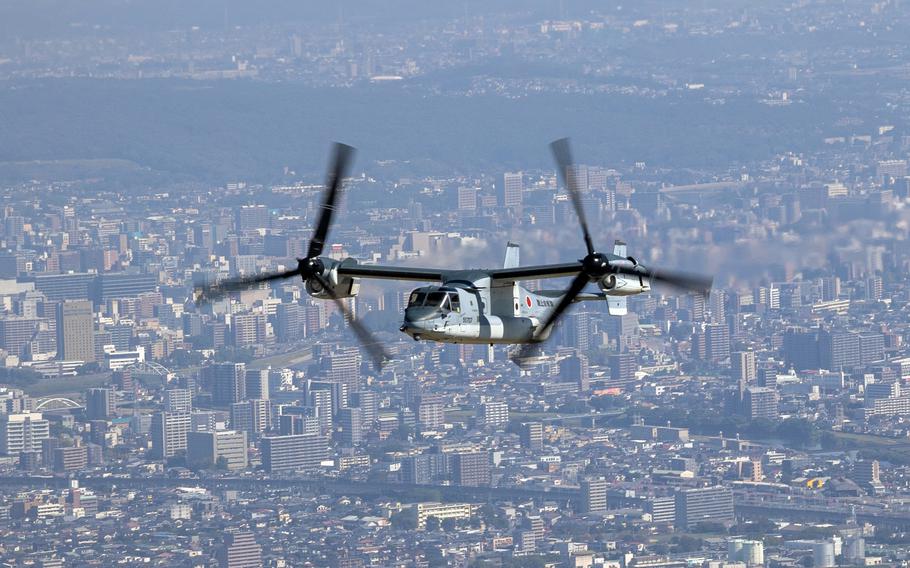
A V-22 Osprey with the Japan Ground Self-Defense flies over Kumamoto, Japan, Oct. 18, 2023. (Kyle Chan/U.S. Marine Corps)
TOKYO — Japan’s military resumed flights of its V-22 Ospreys on Thursday, a week after the U.S. Marines flew theirs again and nearly four months after the fatal crash of a U.S. Air Force CV-22 in southern Japan.
An Osprey of the Japan Ground Self-Defense Force took off from Camp Kisarazu, southeast of Tokyo, following maintenance and other safety measures, Chief Cabinet Secretary Yoshimasa Hayashi said at a news conference.
“As preparations were completed, I have been told that a Ground Self-Defense Force Osprey hovered within the facility at Camp Kisarazu from around 11:40 today and then flew in the airspace around Kisarazu airfield,” Hayashi said Thursday.
Japan grounded its 14 Ospreys following the Nov. 29 crash of an Air Force Osprey off the southern Japanese coast, killing all eight crew members aboard. It was assigned to the 21st Special Operations Squadron at Yokota Air Base in western Tokyo.
Hayashi said Japan’s other Ospreys will return to the air in stages, starting with those that have undergone the necessary safety measures.
Japan, the only country outside the U.S. whose military operates the tiltrotor aircraft, took delivery of its first Ospreys in May 2020. The revolutionary aircraft type is manufactured by U.S. contractor Bell Boeing.
The Marines, Air Force and Navy returned their Ospreys to flight status after Naval Air Systems Command lifted a three-month flight ban on March 8. The Marines on Okinawa were first to report an actual flight in Japan by hovering an Osprey at Marine Corps Air Station Futenma on March 14.
“The MV-22 Osprey is back to full flying operation,” Maj. Rob Martins, spokesman for the 1st Marine Aircraft Wing on Okinawa, told Stars and Stripes by phone Friday.
At Yokota, a spokesman for the 374th Airlift Wing declined to comment on when the Ospreys there may resume flight.
“Due to operational security concerns, we do not comment on specific aircraft movements,” Master Sgt. Nathan Allen said by email Friday. “The timing for the 21st Special Operations Squadron to resume flight operations is based on operational requirements unique to the unit’s mission profile. Any decision to return to flight will fully implement all necessary maintenance, safety, and any necessary procedural changes.”
Allen said the resumption of Osprey flights by U.S. forces in Japan will be closely coordinated between the governments of Japan and the United States.
The loss of the Osprey crew — call sign Gundam 22 — and the return of Osprey pilots and crews to the skies over Japan is treated with sensitivity, Allen said.
“However, it’s important to emphasize that the safety of operators and the effectiveness of operations are top priorities,” he said. “Every step towards resuming CV-22 flights has been done with the diligence necessary to ensure that the return to flight operations is conducted with the utmost regard for the safety of aircrew members and surrounding communities.”
An Air Force investigation into the fatal crash just off Yakushima, an island south of Kyushu, the southernmost of Japan’s four main islands, found “a material failure of a V-22 component.”
The Defense Department has yet to identify the failed component or release a report of the accident investigation.
The Osprey, which takes off and lands like a helicopter but flies like a fixed-wing plane, had been plagued by a problem called hard clutch engagement that can result in catastrophic loss of control.
Japanese communities have expressed concerns about the Osprey’s safety.
Okinawa Gov. Denny Tamaki met Thursday with the III Marine Expeditionary Force commander, Lt. Gen. Roger Turner, to say he is concerned about the resumption of Marine Osprey flights, public broadcaster NHK reported that day.
Turner told Tamaki he is sure that Ospreys can operate safely on Okinawa, NHK reported.
Stars and Stripes reporter Jonathan Snyder contributed to this report.